Last updated: June 26, 2023
Article
Lincoln Home National Historic Site: A Place of Growth and Memory (Teaching with Historic Places)
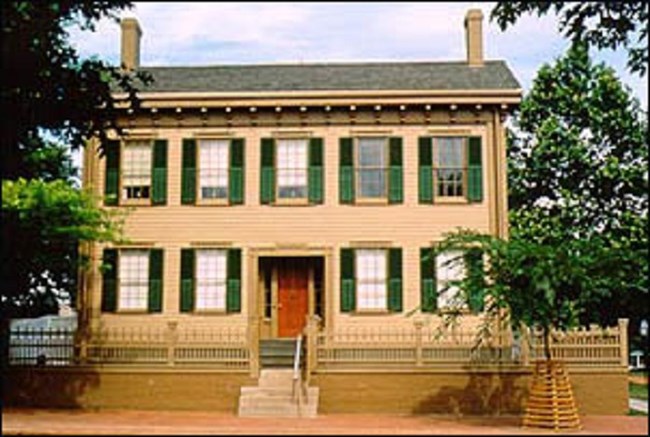
(Courtesy of Lincoln Home National Historic Site)
Abraham Lincoln came of age while living and working as a private citizen in Springfield, Illinois. It was here that he chose to settle down, build a life for himself and his family, and worked hard to achieve success. Lincoln was a husband, parent, and neighbor, who experienced the same hopes, dreams, and challenges of life still experienced by people today. Many of Lincoln's social and political beliefs were formed while he lived in the house at Eighth and Jackson Streets. It was Lincoln's belief in freedom and democracy, his eloquence, and the support of family and community that propelled him to the White House, uplifted him through the turbulent Civil War, and inspired him to turn the war into a "new birth of freedom." It was also to Springfield that Abraham Lincoln was borne in a funeral train to be buried.
Today, hundreds of thousands of people visit the Lincoln Home every year to learn more about the man who fought for the ideals of freedom and democracy. Even during Lincoln's life, when he was an attorney turned president-elect, people came to Springfield at Eighth and Jackson Streets to learn more about Lincoln, his family, and his home. Reporters and photographers also came, charged with telling the rest of America through words and images about the little known, Abraham Lincoln.
About This Lesson
The lesson is based on the National Register of Historic Places registration file "Lincoln Home National Historic Site" (with photographs); maps of the site and surrounding community; and excerpts from primary source documents, including: critical speeches given by Abraham Lincoln, newspaper accounts of Lincoln's nomination and election, and archival photographs of the historic site. The lesson was written by James A. Percoco, a social studies teacher at West Springfield High School in Virginia and History Educator-in-Residence, American University, Washington, DC. It was edited by Timothy P. Townsend, Historian at Lincoln Home National Historic Site and the Teaching with Historic Places staff. This lesson is one in a series that brings the important stories of historic places into the classrooms across the country.
Where it fits into the curriculum
Topics: This lesson plan focuses on Abraham Lincoln's life in Springfield, Illinois, especially when he gained national prominence during the 1860 presidential election. This lesson could be used in American history, social studies, and geography courses in units on the history of the presidency, mid-19th century party politics, the prelude to the Civil War, or on Abraham Lincoln's life and presidency.
Time period: 1831-1865
United States History Standards for Grades 5-12
Lincoln Home National Historic Site: A Place of Growth and Memory
relates to the following National Standards for History:
Era 4: Expansion and Reform (1801-1861)
- Standard 3B- The student understands how the debates over slavery influenced politics and sectionalism.
Era 5: Civil War and Reconstruction (1850-1877)
-
Standard 1A- The student understands how the North and South differed and how politics and ideologies led to the Civil War.
Curriculum Standards for Social Studies
(National Council for the Social Studies)
Lincoln Home National Historic Site: A Place of Growth and Memory
relates to the following Social Studies Standards:
Theme I: Culture
-
Standard D - The student explains why individuals and groups respond differently to their physical and social environments and/or changes to them on the basis of shared assumptions, values, and beliefs.
Theme II: Time, Continuity and Change
-
Standard A - The student demonstrates an understanding that different scholars may describe the same event or situation in different ways but must provide reasons or evidence for their views.
-
Standard C - The student identifies and describes selected historical periods and patterns of change within and across cultures, such as the rise of civilizations, the development of transportation systems, the growth and breakdown of colonial systems, and others.
-
Standard D - The student identifies and uses processes important to reconstructing and reinterpreting the past, such as using a variety of sources, providing, validating, and weighing evidence for claims, checking credibility of sources, and searching for causality.
Theme III: People, Places and Environments
-
Standard A - The student elaborates mental maps of locales, regions, and the world that demonstrate understanding of relative location, direction, size, and shape.
-
Standard D - The student estimates distance, calculates scale, and distinguishes other geographic relationships such as population density and spacial distribution patterns.
-
Standard H - The student examines, interprets, and analyzes physical and cultural patterns and their interactions, such as land uses, settlement patterns, cultural transmission of customs and ideas, and ecosystem changes.
Theme IV: Individual Development & Identity
-
Standard C - The student describes the ways family, gender, ethnicity, nationality, and institutional affiliations contribute to personal identity.
-
Standard D - The student relates such factors as physical endowment and capabilities, learning, motivation, personality, perception, and behavior to individual development.
-
Standard E - The student identifies and describes ways regional, ethnic, and national cultures influence individuals daily lives.
-
Standard F - The student identifies and describes the influence of perception, attitudes, values, and beliefs on personal identity.
Theme V: Individuals, Groups, and Institutions
-
Standard E - The student identifies and describes examples of tensions between belief systems and government policies and laws.
Theme VI: Power, Authority, & Governance
-
Standard C - The student analyzes and explains ideas and governmental mechanisms to meet wants and needs of citizens, regulate territory, manage conflict, and establish order and security.
-
Standard D - The student describes the ways nations and organizations respond to forces of unity and diversity affecting order and security.
Theme X: Civic Ideals and Practices
-
Standard F - The student identifies and explains the roles of formal and informal political actors in influencing and shaping public policy and decision-making.
Objectives for students
1) Describe the community in which Lincoln and his family lived, and learn how the citizens felt about him.
2) Explain the role that the Lincoln home played in Lincoln's personal and political life.
3) Outline the national issues that inspired Lincoln to act decisively in politics and propelled him to the White House.
4) Interview a local politician and compare and contrast this person to what they have learned about Lincoln, and write a "newspaper article" on a current political event in their community.
Materials for students
The materials listed below either can be used directly on the computer or can be printed out, photocopied, and distributed to students. The maps and images appear twice: in a smaller, low-resolution version with associated questions and alone in a larger version.
1)four maps showing where Lincoln lived, slave and free states in the U.S. in 1860, and presidential election results in 1860;
2) four readings about Lincoln in politics including excerpts from key Lincoln speeches, and newspaper accounts of Lincoln's farewell address and funeral in Springfield;
3) four photos of the Lincoln home;
4) one drawing of the Lincoln front parlor.
Visiting the site
The Lincoln home, the centerpiece of the Lincoln Home National Historic Site, has been restored to its 1860s appearance, revealing Lincoln as husband, father, politician, and President-elect. It stands in the midst of a four block historic neighborhood which the National Park Service is restoring so that the neighborhood, like the house, will appear much as Lincoln would have remembered it. The Lincoln Home Visitor Center, located at 426 South Seventh St., is open from 8:30 a.m. to 5 p.m. daily except January 1st, Thanksgiving, and December 25th. Access to the Lincoln Home is available with a free ticket for a specific tour time and tickets are distributed at the Visitor Center Information Desk. School groups, charter tours, or other large groups must reserve tours in advance by contacting the Springfield Convention and Visitors Bureau. The Visitor Center also offers an orientation film, temporary exhibits, a Museum Shop, Springfield area information, and restrooms. Exhibits are also located within the historic Lincoln neighborhood, including "What a Pleasant Home Abe Lincoln Has" in the Dean House, which focuses on the Lincoln family's life in Springfield; and "If These Walls Could Talk" in the Arnold House, which focuses on historic preservation. For more information, contact the Superintendent, Lincoln home National Historic Site, 413 S. Eighth Street, Springfield, Illinois 62701-1905 or visit the park's web site.
Getting Started
Inquiry Question
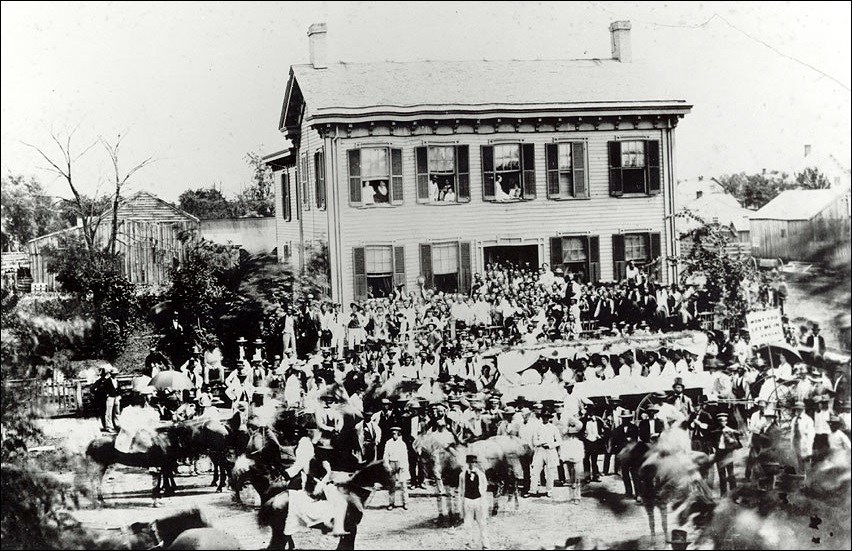
Can you think of a reason that this house or its occupants might attract this crowd?
Setting the Stage
By 1860 Abraham Lincoln was on his way to national fame and the presidency of the United States. But in the early 1850s Lincoln did not hold an elective office and wasn't interested in seeking one. Lincoln had already held a variety of elected offices in the 1830s and 1840s and by the 1850s he was focusing on his prosperous legal career and raising his family. He never totally strayed from politics, however--and gave speeches in support of other candidates. While the national slavery debates were still controversial in the nation--Lincoln and many others were relying on a fragile political peace to keep the country from civil war. That peace was maintained through a series of compromises designed to hold a balance of power between states that allowed slavery and those that prohibited it. These compromises included the Missouri Compromise of 1820, which had admitted Maine as a free state, Missouri as a slave state, and prohibited slavery in the old Louisiana Purchase Territory north of a line marked by the latitude of 36º 30'. Another measure to keep the peace, was the "Compromise of 1850." This series of agreements allowed for, among other things, the admission of California as a free state; it ended the slave trade in the District of Columbia, the nation's capital; and it mandated the return of runaway slaves regardless of where they might be (free or slave state). This last mandate became known as the Fugitive Slave Act.
The nation's tenuous balance of power was tipped in 1854 with the passage of the Kansas-Nebraska Act. This legislation was championed by Illinois Senator Stephen A. Douglas as a way to end the ongoing debates in Congress on admission of a state that prohibits or allows slavery. This act allowed the inhabitants of the territories of Kansas and Nebraska to decide the slavery issue through election. The Kansas-Nebraska Act superseded the Missouri Compromise of 1820 by potentially allowing slavery north of the latitude of 36º 30'. This infuriated many in the north who considered the Missouri Compromise to be a long-standing, binding agreement. Lincoln stated that the repeal of the Missouri Compromise aroused him as he had never been before.
Lincoln returned to political life where he might work towards changing the effect of the Kansas-Nebraska Act. He was elected to the Illinois legislature in 1854, but resigned that seat so that he could run for the United States Senate. The Senate had long been Lincoln's ultimate political goal. Never-the-less, as part of a strategy designed to prevent the election of a rival who supported the Kansas-Nebraska Act, he withdrew his name from consideration in this race to support another candidate.
Lincoln traveled extensively over the next several years giving political speeches. In 1858, he again ran for the U.S. Senate, this time against Stephen A. Douglas, the author of the Kansas-Nebraska Act. Lincoln did well against Douglas, but lost the Senate race and shortly after wrote of his efforts, "I believe I have made some marks which will tell for the cause of civil liberty long after I am gone."¹
Lincoln resumed his travels during the next two years giving speeches throughout the country. His efforts and the notoriety he received during the debates with Douglas caught the attention of Republican Party leaders who began considering him for the presidency in the 1860 election. On May 18, 1860, Lincoln was chosen as the Republican nominee for the presidency at the Republican National Convention in Chicago and received the official notification of his nomination in the parlor of his Springfield home. Later that year, on November 6, 1860, Lincoln won the election, becoming the 16th President of the United States.
¹ Roy P. Basler, Ed. The Collected Works of Abraham Lincoln, 9 Volumes, Abraham Lincoln to Anson G. Henry, November 19, 1858, Vol. 3, p. 340.
Locating the Site
Map 1: Where Abraham Lincoln lived prior to his presidency.
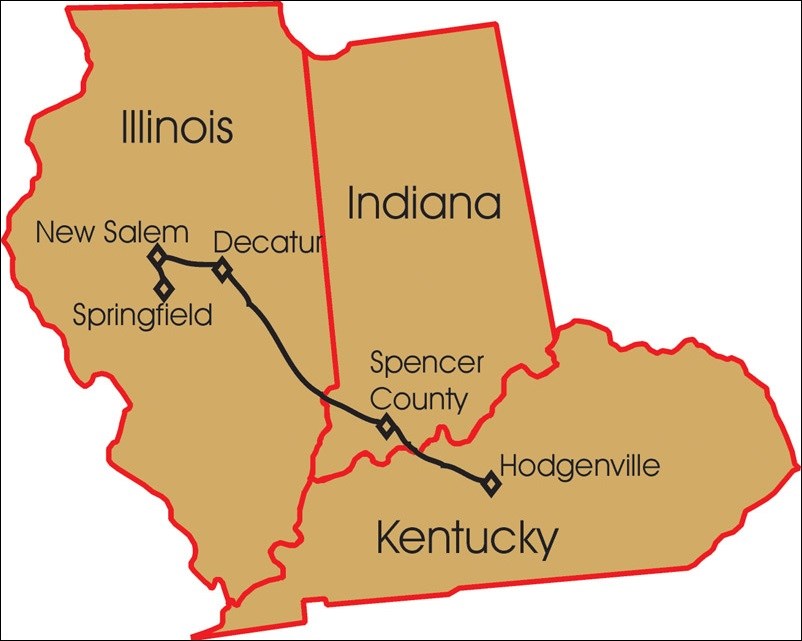
(Courtesy Lincoln Home National Historic Site)
Abraham Lincoln was born on February 12, 1809, in a one-room log cabin, near what is now Hodgenville, Kentucky. His parents were Thomas (a carpenter and farmer) and Nancy Hanks. Lincoln had one sister, Sarah, who was 2 years older and a brother, Thomas, who died when he was still a baby. The Lincoln family moved to Indiana in December 1816, settling near present-day Gentryville.¹ From March 1-15, 1830, the Lincoln family moved to Illinois and settled in Macon County near what is now Decatur. In July 1831, Abraham Lincoln left his family and arrived in New Salem. He was 22 years old. While in New Salem, he worked as a clerk in one store, became part owner of another store that eventually failed, and worked as a postmaster and a surveyor. It was also while living in New Salem that he began studying the law in earnest and was elected to the Illinois legislature. On April 15, 1837, Abraham Lincoln arrived in Springfield with all of his belongings in two saddlebags to begin his law practice. He arranged to share a room with Joshua Speed, a Springfield store owner.
Map 2: Overview of Springfield, Illinois in 1860.
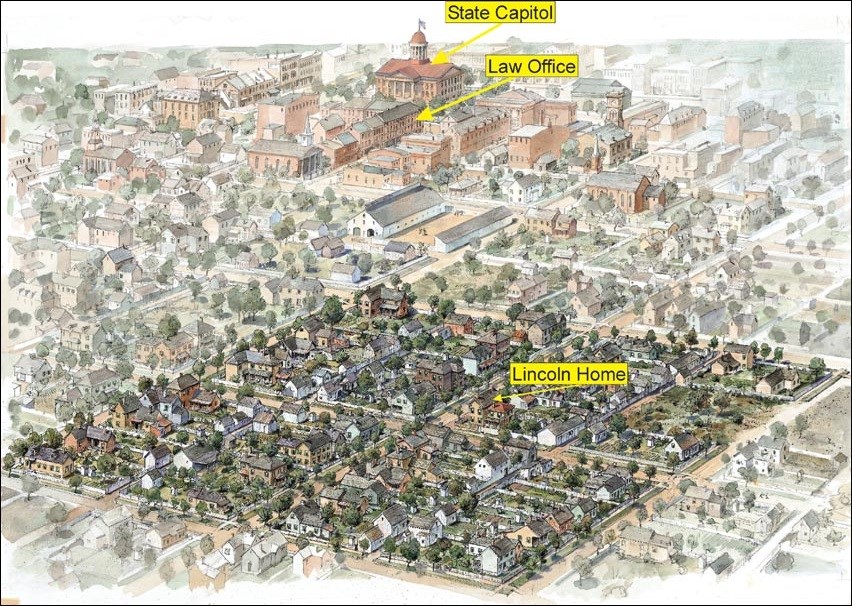
(Courtesy Lincoln Home National Historic Site)
Map 2 was created by an artist based upon research on what 1860 Springfield may have looked like.
Questions for Maps 1 & 2
1. Using Map 1, examine the migration pattern of Lincoln. In which direction did he generally move? Can you think of any reasons why he and his family might move West during the early 19th century? What are some reasons why families might move to a different part of the country today?
2. Locate the Lincoln Home, the Old State Capitol, and Lincoln's Law Office on Map 2. How would you describe the Springfield community?
3. Note the distance from Abraham Lincoln's house at Eighth and Jackson Streets to his law office and the capitol on Map 2. What kind of commute did he have? How do you think he got from place to place?
4. What might be some of the advantages or disadvantages in living and working so close to the seat of power of the state government?
Locating the Site
Map 3: Slave and free states in U.S. in 1860.
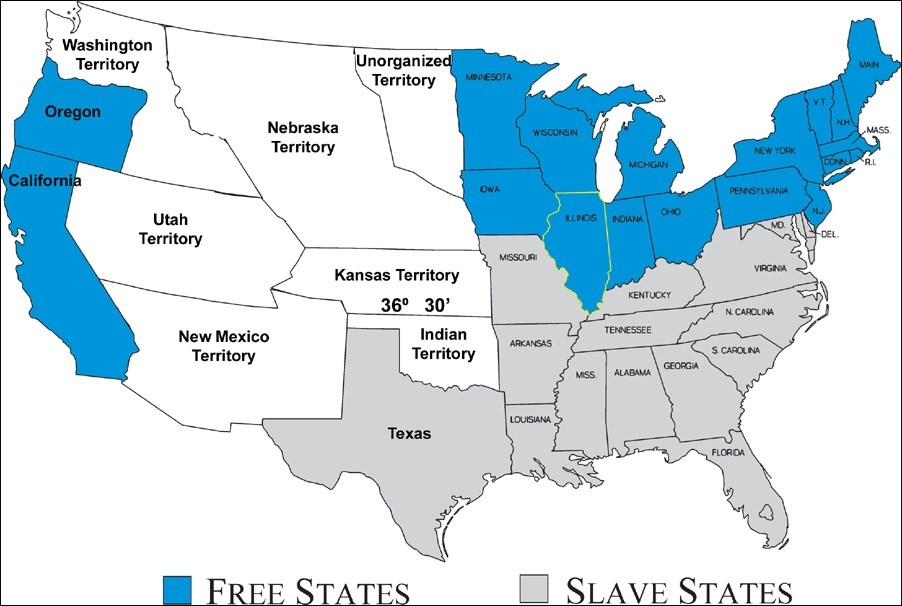
(Courtesy Lincoln Home National Historic Site. Information for the creation of Map 3 was obtained from the Abraham Lincoln Historical Digitization website at http://lincoln.lib.niu.edu.)
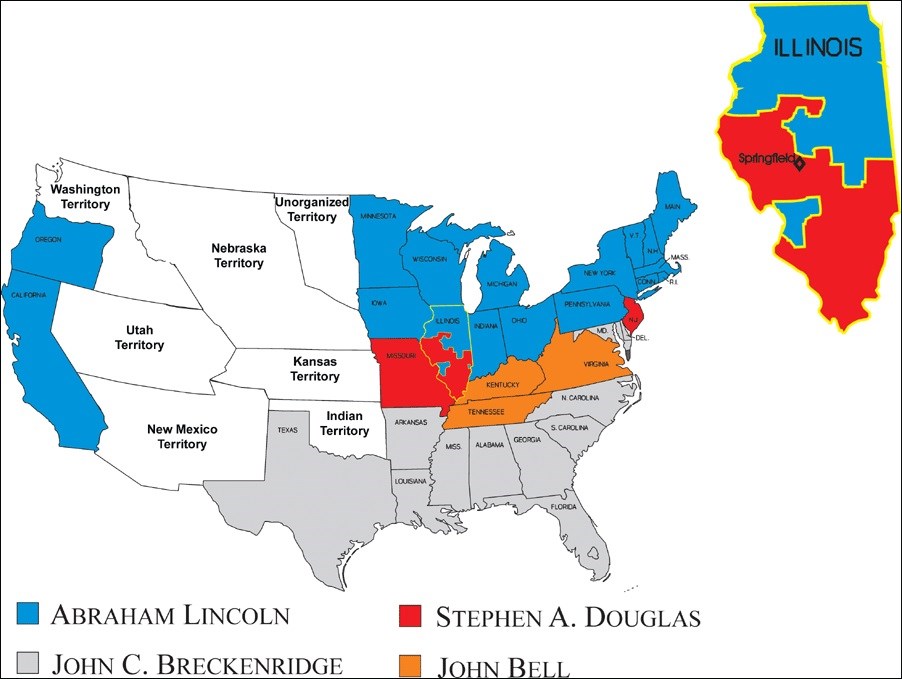
(Courtesy Lincoln Home National Historic Site. Information for the creation of Map 4 was obtained from the Abraham Lincoln Historical Digitization website at http://lincoln.lib.niu.edu.)
In Map 4, the Illinois' results are shown by county.
Questions for Maps 3 & 4
1. Using Map 3 determine how many slave states there were. How many free states were there?
2. Where was the area over which the issue of slavery was most hotly contested during that period? If needed, please refer to Setting the Stage.
3. How do the election results in Map 4 compare with the slave and free states distribution in Map 3?
4. Look at the county results for Lincoln's home state of Illinois on Map 4. What does this illustrate about the views of the voting population of Illinois?
Determining the Facts
Reading 1: From Self-Taught Lawyer to President
Abraham Lincoln was the first man elected to the presidency who was born west of the Appalachian Mountains. His up bringing in backwoods Kentucky, in the remote regions of southern Indiana, and on the Illinois prairie shaped his life. In 1831, when he was 22, Lincoln moved to New Salem, Illinois and in 1834 was elected to the first of five terms to the Illinois legislature. He was encouraged to study law by fellow legislator John Todd Stuart during his first term. In 1837, the lanky self-taught lawyer with only one year of frontier schooling rode his horse into Springfield, Illinois with all of his belongings in two saddlebags.
On November 4, 1842, Lincoln married Mary Ann Todd and by May 1844 the young couple had purchased a small Greek Revival-style cottage at the corner of Eighth and Jackson Streets, the home the family would occupy for the next 17 years. Here three of their four children were born, and one died. Robert Todd Lincoln (1843-1926) was less than one year old when they moved into their new home. He was named for Mary's father and later attended Harvard College. Edward Baker (1846-1850), nicknamed Eddie, died in the house five weeks short of his fourth birthday. William Wallace, or Willie, (1850-1862), was loved by the Lincolns for his bright and inquisitive nature, and found great pleasure romping around the house with his younger brother, Thomas (1853-1871). This youngest child--Mary's "troublesome little sunshine"--was nicknamed Tad by his father, who said he looked like a tadpole. The Lincolns owned a dog they named Fido.
Over the years the Lincolns enlarged the house to accommodate their growing family. In 1846 they added a downstairs bedroom and in 1855, they expanded the story-and-a-half cottage to a full two-story house. While living in this house Lincoln enjoyed great success as a lawyer and was considered one of the state's best courtroom attorneys. His legal practice regularly took him away from Springfield, especially riding the Eighth Judicial Circuit, a traveling court which met three months at a time in the spring and fall at various county seats throughout central Illinois. Their children certainly made the house a lively place, but Mary often felt alone without her husband present.
Mary largely devoted herself to managing the household and raising their children. Much of the domestic and private side of the home was centered on the kitchen. Here Mary oversaw the activities that made this a well-run and inviting home, allowing Lincoln to devote his time and energy to the practice of law and politics. Mary furnished the entire house, choosing the furnishings and drapery with care to reflect the tastes of a prosperous mid-19th century American family.
Abraham Lincoln was a member of the Whig Party when he was elected to the United States House of Representatives in 1846. The Whig party, which operated in the U.S. from 1832 to 1856, supported the supremacy of Congress over the Executive Branch. The party was ultimately destroyed by the question of whether to allow the expansion of slavery to the territories. Following his term in Congress, Abraham Lincoln returned to his Springfield law practice. However, his interest in politics was rekindled by Democratic Senator Stephen A. Douglas' 1854 Kansas-Nebraska Act, which allowed the people of the territories of Kansas and Nebraska to vote to allow or outlaw slavery. Joining the newly formed Republican Party, whose stance was opposed to the extension of slavery, Abraham Lincoln ran against Stephen A. Douglas for the Senate seat in Illinois in 1858. On June 16, 1858 Lincoln delivered his "House Divided Speech" in the Illinois State House where he declared that "A house divided against itself cannot stand. I believe this government cannot endure, permanently half slave and half free."1 Following the "House Divided" speech, Lincoln engaged in a series of debates with Douglas that included stops at seven communities across Illinois and grabbed the nation's attention. The two held a series of seven debates and although Abraham Lincoln lost the election, the debates brought him national prominence.
Lincoln was not convinced of his presidential potential and wrote "I do not think myself fit for the Presidency."2 A year later however, Lincoln's feelings about the presidency had changed and he admitted that "the taste is in my mouth a little."3 The 1860 Republican Party convention, held in Chicago in May, chose Lincoln as its candidate for President. A committee of delegates from the convention traveled to Springfield and, in the Lincoln parlor, introduced themselves to Lincoln and his family and formally notified him of his nomination. The Lincoln home became the center of attention during Lincoln's 1860 presidential campaign. The nation's split over the slavery issue was reflected in the 1860 election, in which two of the four candidates that ran were Democrats. The Democratic Party members from the northern states selected their own candidate as did the Democrats from the southern states. This split in the Democratic Party all but assured that the Republican, Abraham Lincoln, would win. A fourth candidate also ran under the "Constitutional Union Party," which tried to appeal to both northern and southern voters. On November 6, 1860, Republican Abraham Lincoln received 40% of the popular vote to northern Democrat Stephen A. Douglas' 29%, southern Democrat John C. Breckenridge's 18%, and Constitutional Union John Bell's 13%.
As Lincoln left Springfield for the nation's capitol he told those gathered at the train depot to see him off, that upon his shoulders was "a task before me greater than that which rested upon Washington."4 To Abraham Lincoln would fall the task of leading a divided nation during America's greatest crisis--the Civil War, a task for which in the end he would become its greatest casualty.
Questions for Reading 1
1. Why did the Kansas-Nebraska Act rekindle Lincoln's interest in politics?
2. What kinds of jobs did Mary Lincoln have in managing the Lincoln household?
3. Why do you think Lincoln joined the newly formed Republicans when he ran for Senate in 1858? Which party was he affiliated with prior to this?
4. What do you think Lincoln meant by his "House Divided" speech? Do you agree with his sentiments? Why or why not?
5.) Why did the split in the Democratic Party help Lincoln win the election?
1 Roy P. Basler, Ed. The Collected Works of Abraham Lincoln, 9 Volumes, ``A House Divided'': Speech at Springfield, Illinois, June 16, 1858, Vol 2, p. 462.
2 Roy P. Basler, Ed. The Collected Works of Abraham Lincoln, 9 Volumes, Abraham Lincoln to Thomas J. Pickett, April 16, 1859, Vol 3, p. 378.
3 Roy P. Basler, Ed. The Collected Works of Abraham Lincoln, 9 Volumes, Abraham Lincoln to Lymon Trumbull, April 29, 1860, Vol 4, p. 46.
4 Roy P. Basler, Ed. The Collected Works of Abraham Lincoln, 9 Volumes, Farewell Address at Springfield, Illinois, February 11, 1861, Vol 4, p. 191.
Determining the Facts
Reading 2: Excerpts from Key Lincoln Speeches
Below are excerpts of four speeches that Lincoln researched, wrote, rewrote, practiced, and finally presented while he lived in Springfield. Words and text that Lincoln emphasized in his original text are shown here in bold.
Excerpt from Lincoln's "House Divided" Speech at Springfield, Illinois, June, 16, 1858.
Abraham Lincoln delivered this speech upon his acceptance of the Republican Party's nomination to run against Stephen A. Douglas for the United States Senate.
'A house divided against itself cannot stand.'
I believe this government cannot endure, permanently half slave and half free.
I do not expect the Union to be dissolved -- I do not expect the house to fall -- but I do expect it will cease to be divided.
It will become all one thing, or all the other.
Either the opponents of slavery, will arrest the further spread of it, and place it where the public mind shall rest in the belief that it is in course of ultimate extinction; or its advocates will push it forward, till it shall become alike lawful in all the States, old as well as new -- North as well as South.
from The Collected Works of Abraham Lincoln
Roy P. Basler, Editor, Vol. II, pp. 461-462
Excerpts from Lincoln's Address at Cooper Institute, New York City, February 27, 1860.
Lincoln was invited to New York City to give a speech before the Young Men's Central Republican Union of New York and used the opportunity to criticize the expansion of slavery. Lincoln understood the importance of this speech and spent a considerable amount of time researching and crafting his remarks which paid off. This speech introduced Lincoln to eastern audiences and further expanded his fame.
Let all who believe that 'our fathers, who framed the Government under which we live, understood this question just as well, and even better, than we do now,' speak as they spoke, and act as they acted upon it. This is all Republicans ask -- all Republicans desire -- in relation to slavery. As those fathers marked it, so let it be again marked, as an evil not to be extended, but to be tolerated and protected only because of and so far as is actual presence among us makes that toleration and protection a necessity. Let all the guaranties those fathers gave it, be, not grudgingly, but fully and fairly maintained.
Neither let us be slandered from our duty by false accusations against us, nor frightened from it by menaces of destruction to the Government nor of dungeons to ourselves. Let us have faith that right makes might, and in that faith, let us, to the end, dare to do our duty as we understand it.
from The Collected Works of Abraham Lincoln
Roy P. Basler, Editor, Vol. III, pp. 535, 543, 546-47, 550
Excerpts from Lincoln's First Inaugural Address, March 4, 1861.
In his inaugural address, Lincoln tried to avoid civil war and reassure the southern states that he had never advocated the removal of slavery where it existed, but rather was opposed only to the expansion of slavery.
One section of our country believes slavery is right, and ought to be extended, while the other believes it is wrong, and ought not to be extended. This is the only substantial dispute.
In your hands, my dissatisfied fellow countrymen, and not in mine is the momentous issue of civil war. The government will not assail you. You can have no conflict, without being yourselves the aggressors. You have no oath registered in Heaven to destroy the government, while I shall have the most solemn one to 'preserve, protect, and defend' it. I am loathe to close. We are not enemies, but friends. We must not be enemies. Though passion may have strained, it must not break our bonds of affection. The mystic chords of memory, stretching from every battle-field, and patriot grave, to every living heart and hearthstone, all over this broad land, will yet swell the chorus of Union, when again touched, as surely they will be, by the better angels of our nature.
from The Collected Works of Abraham Lincoln
Roy P. Basler, Editor, Vol. IV, pp. 262-63, 268-69, 271
Questions for Reading 2
1. What connection can you make between these four speeches?
2. What is Abraham Lincoln's position on the expansion of slavery?
3. How do these speeches reflect Abraham Lincoln's attitude about democracy? What is your evidence?
4. Why did Lincoln work so hard to appeal to the southern states in this First Inaugural Address?
Determining the Facts
Reading 3: Abraham Lincoln's Springfield Farewell Address
On February 11, 1861, Abraham Lincoln departed Springfield for Washington, DC and an uncertain presidency of a nation on the brink of civil war. He was met at the Springfield train station by an estimated 1,000 of his friends and neighbors who wanted to wish him well. The following is an account of the farewell as reported in a Springfield newspaper the following day.
Daily State Journal
Tuesday, February 12, 1861
Departure of Mr. Lincoln -- Parting Address
Long before the hour appointed for the departure of the special train for Mr. Lincoln and suit, hundreds of his friends and fellow-citizens, without distinction of party, had assembled at the station of the Great Western Railway to tender him their respects, grasp once more that honest hand, and bid him God speed on his eventful journey. A subdued and respectful demeanor characterized the vast assemblage. All seemed to feel that they were about to witness an event which, in its relations to the future, was of no ordinary interest.
At precisely five minutes before eight o'clock, Mr. Lincoln, slowly made his way from his room in the station, through the expectant masses which respectfully parted right and left at his approach to the car provided for his use. At each step of his progress towards the car, friendly hands were extended for a last greeting. On reaching the platform of the car, Mr. Lincoln turned toward the people, removed his hat, paused for several seconds, till he could control his emotions, and then slowly, impressively and with profound emotion uttered the following words:
Friends, no one in a like position, can understand my feelings at this hour, nor the oppressive sadness I feel at this parting. For more than a quarter of a century I have lived among you, and during all that time I have received nothing but kindness at your hands. Here I have lived from my youth until now I am an old man. Here the most sacred ties of earth were assumed; here all my children were born; and here one of them lies buried. To you, dear friends, I owe all that I have, all that I am. All the strange chequered past seems to crowd now upon my mind. Today I leave you; I go to assume a task more difficult than that which devolved on General Washington. Unless the great God who assisted him, shall be with and aid me, I must fail. But if the same omniscient mind, and the same almighty arm that directed and protected him, shall guide and support me I shall not fail, I shall succeed. Let us all pray that the God of our fathers may not forsake us now. To him I commend you all - permit me to ask that with equal serenity and faith, you will invoke His wisdom and guidance for me. With these few words I must leave you - for how long I know not. Friends one and all, I must now bid you an affectionate farewell.
It was an impressive scene. We have known Mr. Lincoln for many years; we have heard him speak upon a hundred different occasions; but we never saw him so profoundly affected, nor did he ever utter an address, which seemed to us as full of simple and touching eloquence, so exactly adopted to the occasion, so worthy of the man and the hour. Although it was raining fast when he began to speak, every hat was lifted and every head bent forward to catch the last words of the departing chief. -- When he said, with the earnestness of a sudden inspiration of feeling, that with God's help he should not fail, there was an uncontrollable burst of applause.
At precisely eight o'clock, city time, the train moved off, bearing our honored townsman, our noble chief, ABRAHAM LINCOLN, to the scenes of his future labors, and as we firmly believe of his glorious triumph. God bless honest ABRAHAM LINCOLN.
Questions for Reading 3
1. What did the reporter mean when he wrote that Lincoln's departure was an event "of no ordinary interest?"
2. According to this reporter, what is the sentiment of the people of Springfield towards Abraham Lincoln?
3. How would you describe Abraham Lincoln's Farewell Address? How long was it? How does Abraham Lincoln's sentiments compare to any prior image or perception of Abraham Lincoln that you may have had before reading the Farewell Address?
4. How does Lincoln compare the challenge of his presidency with that of George Washington? Do you agree with him? Why or why not?
Determining the Facts
Reading 4: Springfield Newspaper Account of Abraham Lincoln's Funeral
On March 3, 1860 Abraham Lincoln was inaugurated as the 16th President of the United States. Less than a month later, on April 12, 1861, the Confederacy fired on Fort Sumter in South Carolina. Tragedy struck the family on February 20, 1862, when their son Willie died of a malarial infection. On July 1, 1863 Lincoln issued an emancipation proclamation which declared slaves free in most areas of the Confederacy and set the stage for the total end of slavery. On November 19, 1863, Lincoln gave a speech at Gettysburg, Pennsylvania, that honored the soldiers who had died in the July battle there and stated in very few words why the war for democracy and freedom was so important. A year later, Lincoln won reelection as President and by the end of 1864, focused on ending the war and the reunification of the Union. Just days after he led the Union to victory, a southern sympathizer--John Wilkes Booth--shot Lincoln on April 14, 1865, while he and his wife Mary attended a play at Ford's Theatre. The unconscious Lincoln was taken to a rooming house across the street, where he died the next day. Following Lincoln's death, his remains were returned to Springfield. The following is an account of Lincoln's funeral as reported in a Springfield newspaper.
Daily State Journal
Thursday, May 4, 1865
"How They Loved Him"
If any evidence were needed of the love of the people for Abraham Lincoln and their confidence in him, it is furnished by the remarkable spectacle of the last few days. Never did a conqueror, in the hour of his proudest triumph, receive such proof of the devotion of a nation, as that which has been accorded to the remains of the martyred President on their way to be deposited in their last resting place.
Amid the magnificent pageants which have been witnessed in their progress from city to city, one thing has been prominent--and that is, the profound feeling which has touched all hearts. The decorations which have been witnessed as the sorrowful procession advanced from place to place, have been unparalleled in the history of this country, and perhaps scarcely equaled in any other. The whole nation has risen up to do homage to his memory.
If the feelings of sorrow on the part of the people have been deep and real, elsewhere, they have been even more so in our late President's state and home. Here his virtues were appreciated and the struggles by which he so worthily arose to such distinction, as well as the difficulties with which he has had to contend with through four years of the most stupendous war, were fully understood. Here were those who never lost faith in the pilot at the helm, even when the storm of civil war beat most violently about the "ship of state." Here he always received sympathy and encouragement from those who knew him best.
The events of yesterday and to-day in this community are full of the most impressive significance. From our midst, a little more than four years ago, President Lincoln was called to the highest office in the gift of the people. Yesterday, all that is mortal of him returned to us wrapped in the habiliments of the grave. Thousands who loved the man for his virtues and the cause for which he was the noble champion, wept at the ruin for which the assassin has wrought. The emblems of mourning everywhere displayed, the solemn strains of martial music, the slow and measured tread, the sad countenances of the people, all told of the grief which touched all hearts. Illinois receives her murdered son again to her bosom, no less loving than when she sent him forth to the most distinguished honor. To-day we lay him reverently to rest amid the scenes he loved so well. Millions will drop a tear to his memory, and future generations will make pilgrimages to the tomb. Peace to his ashes.
Questions for Reading 4
1. Based on this account, how did the people of Springfield feel about Abraham Lincoln? Why do you think they feel the way they do?
2. How do the sentiments in these articles compare with the sentiments offered in the newspaper accounts of the 1860 rally?
3. Do you think the whole country felt as positively about Lincoln and his legacy at his death? Who might have held another opinion? Why?
Visual Evidence
Photo 1: Lincoln Home, 1860.
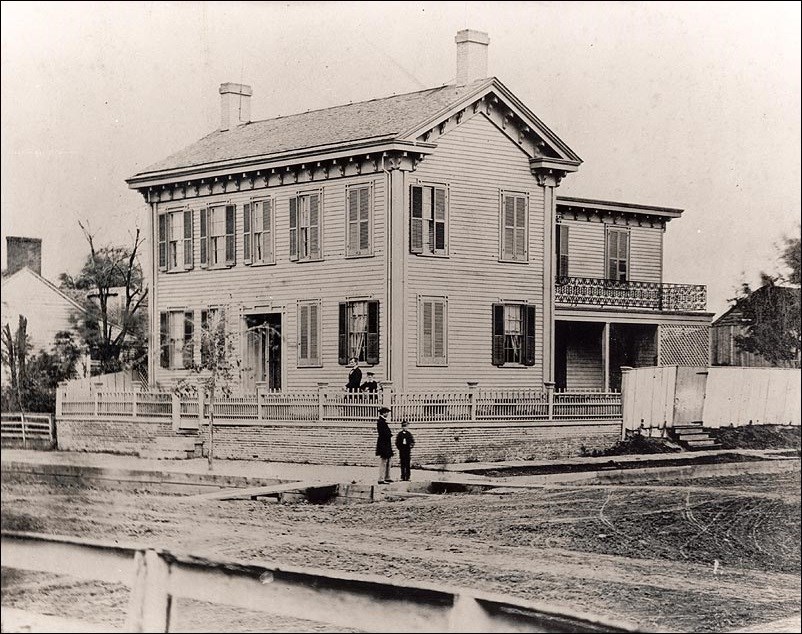
(Courtesy Abraham Lincoln Presidential Library & Museum)
This photo of the Lincoln home was taken by Boston photographer John Adams Whipple during the summer of 1860 and features Lincoln and his son Willie, standing together behind the fence and Tad is peeking from behind the corner post. Reporters and photographers came to Springfield, charged with telling the rest of America through words and images, about the little known, Abraham Lincoln. Following are several accounts:
New York Evening Post
May 23, 1860
I found Mr. Lincoln living in a handsome, but not pretentious, double two-story house, having a wide hall running through the centre, with parlors on both sides, neatly, but not ostentatiously furnished. It was just such a dwelling as majority of the well-to-do residents of these fine western towns occupy. Everything about it had a look of comfort and independence. The library, I remarked on passing, particularly, that I was pleased to see long rows of books, which told of scholarly tastes and culture of the family.
Springfield Massachusetts Republican
May 23, 1860
As nearly as could be made out in the evening light [of May 19], his dwelling house is of the style and character suited to his position in life. It is a two-story wooden house of more than extraordinary good exterior; and the interior arrangements are such as show that good taste and good domestic rule reigns within. The furniture, without pretension to show, was neat, and in admirable keeping with what is understood to be his moderate pecuniary ability. Everything tended to represent the home of a man who has battled hard with the fortunes of life, and whose hard experience has taught him to enjoy whatever of success belongs to him, rather in solid substance than in showy display.
Questions for Photo 1
1. What is your impression of the Lincoln Home after viewing Photo 1?
2. What did the Springfield Massachusetts Republican reporter mean when he wrote that Lincoln's "house is of the character suited to his position in life?"
3. Why would reporters and photographers be at the Lincoln home in 1860? If needed, please refer to Reading 1.
4. Why do you think the public would be interested in Lincoln's home and family life? Would reporters be able to provide the same type of personal information for presidential candidates today? Why or why not?
Visual Evidence
Photo 2: Republican rally, 1860.

(Courtesy Abraham Lincoln Presidential Library & Museum)
On August 8, 1860, participants in a Republican rally were parading past the Lincoln Home, on their way to the state fairgrounds, and stopped in front of the Lincoln Home for a photograph. The parade included a wagon that carried 33 ladies dressed in white, representing the states in the Union. The admission of Kansas to the Union caused many problems for the nation because of the controversy over admitting it as a free state or one that allowed slavery. A lone lady, also in white, is following them in a small buggy representing Kansas with a sign that reads "Won't you let me in."
Woodstock Sentinel
Wednesday Morning, August 15, 1860
The Great Springfield Rally
A MASS MEETING of 80,000
"OLD ABE" AT HOME!
The train at last reached Springfield at a little after nine o'clock in the morning, making the trip from Chicago to Springfield in twelve hours. The thunder of the cannon and the continued cheering, announced that the Northerners had arrived. We found the streets in every direction a complete mass of people, and crowding our way through we booked ourselves at the Chenery House, and by good fortune secured a nicely furnished room in an adjoining building for the accommodation of the entire delegation. We then sailed forth in quest of adventure, and accordingly crowded through to the State House. This is a fine building, similar to the Chicago Court House… From there we adjourned to Old Abe's residence where for three mortal hours a procession of almost countless numbers passed by, every wagon load or company cheering Mr. Lincoln enthusiastically, that distinguished gentleman standing on his door steps, gracefully acknowledging their compliments. The procession is acknowledged to be the most striking political demonstration of the kind ever made. Among its principal features were 22 companies of Wide Awakes, ten beautifully decorated caravans of young ladies, a full rigged schooner, with sailors, a huge wagon drawn by six horses, on which was a small power loom driven by a live steam engine; the next feature was an immense wagon drawn by 26 yoke of oxen, on which was represented almost every department of mechanical labor; there were quite a number of wagons on which men were splitting rail, &c.; among the ingenious and numberless devices and banners, were several representing Mr. Douglas as imbibing "My Great Principle" from the mouth of a stone jug, &c.
After the procession we were introduced to, and shook hands with Mr. and Mrs. Lincoln. Our readers well know how Old Abe looks, so to suffice it to say of Mrs. Lincoln that she is a very accomplished lady, and will grace the White House, which we told she was to inevitably occupy, very becomingly.
Questions for Photo 2
1. Why would supporters hold a rally at a candidate's home? Why do you think that this does not happen in modern campaigns?
2. Who is the "Mr. Douglas" referred to in the article?
3. Do you think that the reporter was a supporter of Lincoln? Why or why not?
4. The "Wide Awakes" was a radical faction within the Republic Party. Can you think of single-issue political alliances today? What do they call themselves?
5. Compare and contrast Photo 2 with the newspaper account. What connections can be made between the article and the photo? Is the newspaper account validated by the image?
6. How would you describe Photo 2? Compile a list of people and objects. Identify Abraham Lincoln who is in the photograph. How would you describe the mood of the people and the tone of the photo?
Visual Evidence
Drawing 1: Illustration of the Lincoln's front parlor, 1860.
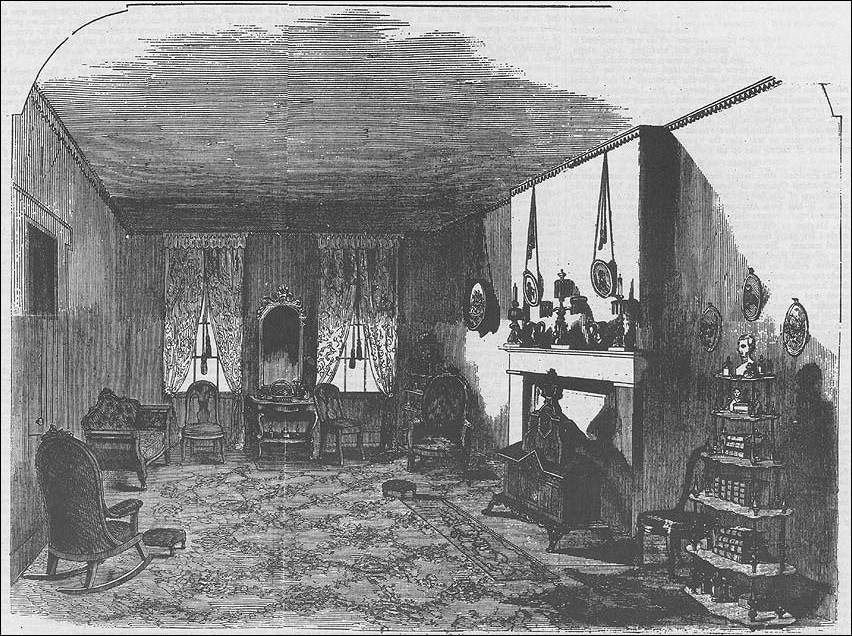
(Courtesy Lincoln Home National Historic)
An artist working for Frank Leslie's Illustrated Newspaper, visited Springfield to learn more about Abraham Lincoln, his family, and community. He drew illustrations of three first floor rooms within the Lincoln Home that were published in the newspaper on March 9, 1861. Visits from artists, reporters, photographers and others helped satisfy the nations' curiosity about the relatively unknown Abraham Lincoln.
Photo 3: Restored formal parlor within the Lincoln Home.
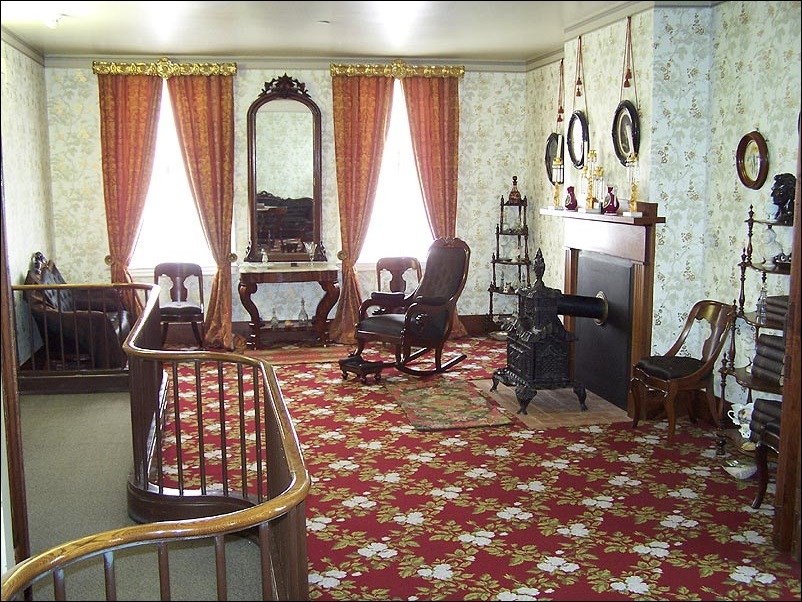
(Courtesy Lincoln Home National Historic)
Using the historic 1860 engraving that appeared in Frank Leslie's Illustrated Newspaper, as well as other information, the National Park Service has attempted to restore the Lincoln Formal Parlor, where Lincoln received notification of his nomination for the presidency.
Questions for Drawing 1 and Photo 3
1. Compare the 1860 illustration with the modern photograph of the restored Lincoln home parlor. What are the similarities and differences between the two? What might account for the differences?
2. The information provided in the 1860 engraving is not in color. How do you think researchers might have been able to decide what color wallpaper, carpeting, and paint would be correct in the Lincoln home restoration?
3. Why do you think it is important to restore the parlor to the year 1860? How does this help us learn about what Lincoln's life was like at the time?
Visual Evidence
Photo 4: Funeral Dignitaries in front of Lincoln's Home, May 1865.
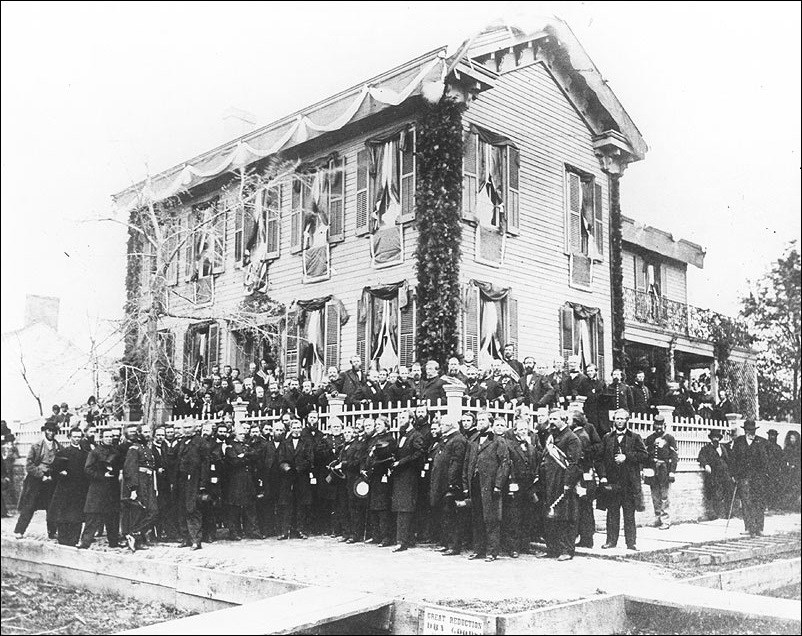
(Courtesy Abraham Lincoln Presidential Library & Museum)
A shocked nation was thrown into mourning upon receiving word of the assassination of Abraham Lincoln. After funeral services in Washington, the Lincoln funeral train, with Lincoln's remains and those of his son Willie, departed Washington and began a 12-day trip back to Springfield. The funeral train arrived in Springfield on May 3, and Lincoln's remains were placed in the Representative's Hall of the State House. The following day, the Lincoln funeral procession left the state house and passed buildings associated with Lincoln's life that were draped in mourning, on its way to Oak Ridge Cemetery, where Lincoln and Willie were laid to rest.
Daily State Journal
Thursday, May 4, 1865
"The President's House"
Large numbers of citizens and strangers visited the former residence of the late President, at the corner of Eight and Jefferson [Jackson] streets. It was most tastefully decorated with the national mourning colors and evergreens. The delegation of one hundred from Chicago repaired to the house and had their photographs taken in connection with the house, as a memorial of a solemn occasion and visit.
Questions for Photos 4
1. Analyze Photo 4. How does Photo 4 compare and contrast with how the house looks in Photos 1 and 2? What are the similarities? What are the differences? How do the tones or moods in the different photos compare?
2. Why do you think delegates would pose in front of Lincoln's home in the aftermath of his tragic death?
3. How does the text of Reading 4 compare to what you see in Photo 4?
Putting It All Together
In this lesson, students learn how Abraham Lincoln's belief in freedom and democracy, his eloquence, and the support of family and community propelled him to the White House and uplifted him through the turbulent Civil War. The following activities will help them apply what they have learned.
Activity 1: A Springfield Newspaper Account
Have students further research the topics listed below using the Internet, the library, their textbooks, etc. Combining what they learn with the information presented in this lesson, have students write a newspaper account as if they were reporting on one of the following stories:
Lincoln's "House Divided Speech" (1858)
Lincoln's Republican Party Presidential Nomination (1860)
The Election of Abraham Lincoln (1860)
Lincoln's Farewell from Springfield (1861)
Lincoln's Funeral (1865)
Activity 2: A Visit from a Hometown Politician
Invite a locally elected official--mayor, city council member, state representative, school board member, etc.--to speak to your class on his or her experience in politics. Have students ask questions about the official's background; their career that brought them to politics; what personally drew the person into politics; what drives them now; and, what unexpected crises have they had to deal with. Following the interview hold a class discussion having students make comparisons between the local official and Abraham Lincoln.
Activity 3: Modern Reporting
Have students review the newspaper articles from this lesson. Then have students read articles dealing with politicians and political events in a present-day local or national newspaper. Hold a class discussion on the similarities or differences in how reporters wrote during Lincoln's time compared to today. Now have students write their own report of a current political event that either happened in your community or that they witnessed on the television.
Lincoln Home National Historic Site: A Place of Growth and Memory--
Supplementary Resources
By studying Lincoln Home National Historic Site: A Place of Growth and Memory students learn how Abraham Lincoln's belief in freedom and democracy, his eloquence, and the support of family and community propelled him to the White House and uplifted him through the turbulent Civil War. Those interested in learning more will find that the Internet offers a variety of interesting materials.
Lincoln Home National Historic Site
Lincoln Home National Historic Site is a unit of the National Park Service. The Lincoln home, the centerpiece of the Lincoln Home National Historic Site, has been restored to its 1860s appearance, revealing Lincoln as husband, father, politician, and President-elect. It stands in the midst of a four block historic neighborhood which the National Park Service is restoring so that the neighborhood, like the house, will appear much as Lincoln would have remembered it. The Lincoln Home National Historic Site web page contains information on visiting the historic site, information on the Lincoln family, information on the issues of freedom and democracy that Lincoln and his contemporaries were facing, virtual tours of the Lincoln Home and neighborhood, and much more.
Abraham Lincoln Birthplace National Historic Site
Lincoln's Birthplace is a unit of the National Park Service. Visit the park's website for more information about the memorial building at the site of Lincoln's birth.
Lincoln Boyhood National Memorial
Lincoln Boyhood National Memorial, a unit of the National Park Service, preserves the site of the farm where Abraham Lincoln spent 14 formative years of his life, from the ages of 7 to 21. Visit the park's website for more information about Lincoln's family and life on the frontier.
National Park Service - Museum Management Program
American Presidents & First Ladies: Abraham Lincoln and Mary Todd Lincoln is an online exhibit exploring the lives of the Lincolns at their home in Springfield, IL where the backwoods lawyer and sometimes unsuccessful politician became President-elect during a troubled time in our nation's history. The Museum Management Program also has five lesson plans focused on the Lincolns in their Teaching with Museum Collections series: Lincoln's Legal Career, Reminder of the Past, Lincoln Keepsakes, Lincoln - The Candidate: "The Taste is in My Mouth a Little," The Abraham Lincoln Home in Springfield, IL, and Mary Todd Lincoln and the Boys.
Library of Congress: Historic American Buildings Survey (HABS)/ Historic American Engineering Record (HAER) Collection
Search the HABS/HAER collection for detailed drawings, pictures, and documentation from their survey of the Lincoln Home Site in Springfield, Illinois. HABS/HAER is a division of the National Park Service.
Library of Congress--American Memory Collection
The complete Abraham Lincoln Papers at the Library of Congress consists of approximately 20,000 documents. The collection is organized into three "General Correspondence" series which include incoming and outgoing correspondence and enclosures, drafts of speeches, and notes and printed material. Most of the items are from the 1850s through Lincoln's presidential years, 1860-65. Treasures include Lincoln's draft of the Emancipation Proclamation, his March 4, 1865, draft of his second Inaugural Address, and his August 23, 1864, memorandum expressing his expectation of being defeated for re-election in the upcoming presidential contest.
National Archives--The Emancipation Proclamation
President Abraham Lincoln issued the Emancipation Proclamation on January 1, 1863, as the nation approached its third year of bloody civil war. The proclamation declared "that all persons held as slaves" within the rebellious states "are, and henceforward shall be free."
Gilder-Lehrman: The Lincoln Institute
The Lincoln Institute concentrates on providing support and assistance to scholars and groups involved in the study of the life of American's 16th President and the impact he had on the preservation of the Union, the emancipation of slaves, and the development of democratic principles which have found worldwide application.
Illinois Historic Preservation Agency
The Papers of Abraham Lincoln is a long-term project dedicated to identifying, photographing, and publishing, both comprehensively in electronic form and selectively in printed volumes, all documents written by or to Abraham Lincoln during his entire lifetime (1809-1865).
Indiana Historical Society
IHS acquired three nationally significant Lincoln collections, the Jack Smith Lincoln Graphics Collection, the Daniel R. Weinberg Lincoln Conspirators Collection, and the Alexander Gardner Lincoln Glass Plate Negative. The Smith collection consists of over 700 original photographs, lithographs, engravings, and busts of Lincoln. The Weinberg collection consists of photographs, manuscripts, books, pamphlets, and newspapers relating to the trial and execution or imprisonment of the Lincoln assassination conspirators. The centerpiece of this collection is the original collodion wet-plate negative of the portrait of Abraham Lincoln made by Alexander Gardner. Lincoln sat for this photograph on 8 November 1863, just 11 days before delivering the Gettysburg Address.
